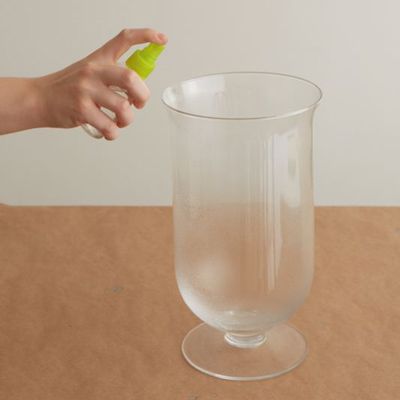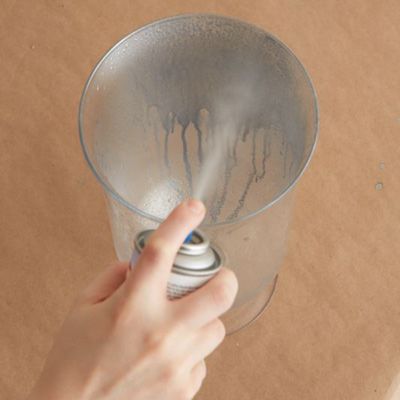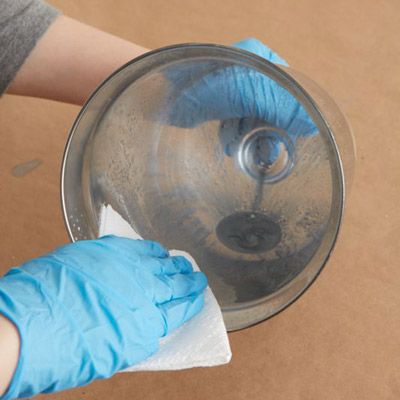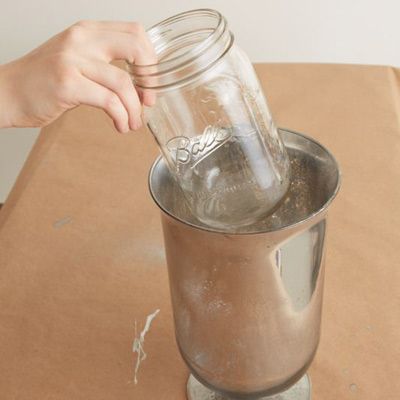Project details
Skill
Cost
Estimated Time
Mercury glass, with its shimmering, antiqued appearance, adds a touch of vintage elegance to any home decor. While authentic mercury glass can be expensive and difficult to find, you can easily create a similar look using new glass pieces and some simple techniques. This DIY project allows you to transform ordinary glass into stunning faux mercury glass, perfect for vases, candle holders, or decorative accents.
*Unless otherwise noted, costs in this article reflect an average of prices that our team found from hardware stores like Lowes and Home Depot, and on Amazon.com.
Prep the Glass Piece to Look Like Mercury
Before beginning the transformation process, you must prepare your glass piece properly. This step ensures that the paint adheres correctly and creates the desired effect. A well-prepared piece is key to achieving a professional-looking result that lasts.

Start by thoroughly washing and drying the glass piece you’ve selected for this project. Any residue or fingerprints can interfere with the paint application, so take care to clean the surface thoroughly with mild soap and water. Once clean, place the piece on its side and use a spray bottle to spritz the bottom of the interior with water. The goal is to create small beads of water on the glass surface, which will help create the characteristic mottled appearance of mercury glass. This simple step is important in determining the final look of your glass.
Spray a Coat of Mercury Colored Paint
Applying the first coat of paint is an essential step in achieving the mercury glass effect. This initial layer sets the foundation for the metallic finish, giving you the base on which to build subsequent layers.

Before you begin painting, shake the spray paint can vigorously for at least two minutes. This ensures that the paint is well-mixed and ready for application. Make sure you’re working in a well-ventilated area and put on a protective face mask and nitrile gloves to protect yourself from paint fumes and overspray.
Angle the spray paint can into the vase, focusing on the wet surface you created in the previous step. Apply one light coat using short, controlled spurts. Be careful not to oversaturate the surface, as this can lead to drips and an uneven finish. A gradual buildup of paint will result in a more natural-looking effect, allowing light to interact with the painted surface more effectively.
Spray a Second Coat
Adding a second coat of paint helps to enhance the mirrored effect and provides better coverage for a more authentic mercury glass appearance. This step deepens the reflective quality and fills in any inconsistencies.

After applying the first coat, allow the paint to dry for approximately 10 minutes. During this time, you should notice the color changing from a dull silver to a more reflective, mirrored finish when viewed from the outside of the glass.
Once the initial coat has set, apply a second light coat of paint. This additional layer will help intensify the metallic effect and fill in any areas that may have been missed during the first application. Remember to maintain the same short, controlled spraying technique to ensure an even paint distribution. Consistency in application is necessary to achieve the desired appearance.
Dab Dry
The dabbing process is what gives mercury glass its distinctive mottled appearance, creating a beautifully aged and antiqued look. This step is vital for achieving the irregular pattern that characterizes authentic mercury glass.

As the paint begins to dry, take a clean paper towel and gently dab the inside of the glass. This step serves two purposes—it absorbs excess water and enhances the mottled finish characteristic of mercury glass. Pay special attention to areas where water droplets have formed, as these will create interesting patterns in the paint.
While dabbing, you may notice some paint pooling at the bottom of the vase. Use the paper towel to carefully sop up any excess paint, ensuring a more even finish throughout the piece. This step also helps prevent drips or runs that could detract from the overall appearance. Taking your time here will ensure a quality finish that stands out.
Repeat and Let Dry
To achieve a uniform look and ensure complete coverage, you’ll need to repeat the process for all sides of your glass piece. This step ensures a cohesive appearance, allowing the entire piece to reflect light in a unified manner.
Carefully turn the vase to access any untreated areas and repeat the spraying and dabbing process. This ensures that the entire interior surface of the glass receives the mercury glass treatment. For a more opaque finish, you may choose to add another coat of paint to the inside of the hurricane vase. Each additional coat will further enhance the depth and richness of the metallic glow.
Once you’ve completed the painting process, allow the piece to dry for at least 24 hours before using or handling it. This drying time is vital to ensure that the paint has fully set and adhered to the glass surface, making it durable enough for everyday use.

If you plan to use your newly created mercury glass piece as a vase for cut flowers, place a smaller glass or jar inside to hold the water safely and stems. This will protect your faux mercury glass finish from water damage and make cleaning easier, ensuring your work of art remains stunning over time.
Materials Needed to Make New Glass Look Like Mercury Glass
 Spray bottle
Spray bottle Protective face mask
Protective face mask Nitrile gloves
Nitrile gloves




